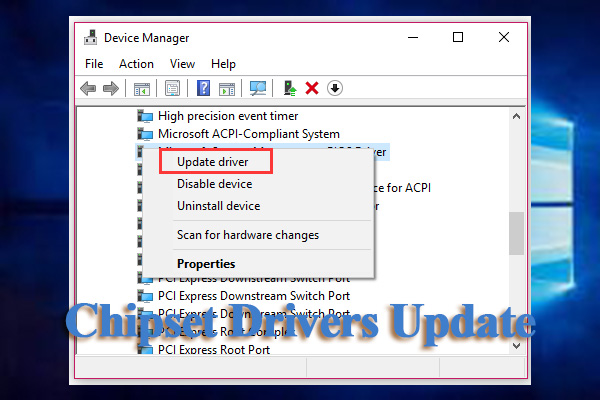The controller is the interface with the motherboard. Then expand Universal Serial Bus controllers. All of the USB controller drivers will be listed here. Then expand the System devices. We can find the remaining motherboard drivers here, including the memory controller, PCI bus driver, system speaker and clock. The motherboard drivers act like a software interface in between the hardware motherboard of the computer and the software of the system. As the motherboard monitors the overall functioning of the computer system, the presence of updated and fully working drivers are essential to managing the important functions of the computer system.
This article clarifies some confusion that vendors have experienced about how hardware that complies with PCI Power Management (PCI-PM) interacts with device drivers in the operating system and about how PCI-PM integrates with ACPI. For more information, see https://www.uefi.org/specifications
Device drivers and PCI power management
This discussion assumes that you are familiar with how Windows Driver Model (WDM) drivers handle power management events, as described in the current Windows DDK. In general, the responsibilities for device drivers are as follows:
Bus drivers: Bus drivers are responsible for enumerating, configuring, and controlling devices. For PCI-PM, the PCI driver is responsible for reading the PCI-PM registers to determine the capabilities of the hardware. When POWER IRPs request power state changes, the PCI driver writes to the PCI power management registers to set the hardware to different Dx states.
When a device is enabled for wake-up, the PCI driver writes to PCI-PM registers to enable the device to fire PME (ACPI will also take an action, see the next section). Finally, when ACPI determines that the PCI bus is waking the system, the PCI driver scans PCI configuration space looking for which device is asserting PME, disables PME in that device, and notifies the driver for that device.
Device driver: The specific driver for the device is responsible for saving and restoring device context, and requesting power state changes as the policy owner for the device. When the device driver receives a POWER IRP requesting a lower device power state change, the device driver is responsible for saving any proprietary device context needed to later turn on the device. In some cases, there may be nothing to save.
PCI-PM registers are strictly the domain of the PCI driver--the IHV's device driver does not need to access any of these registers. Doing so would cause the system to not work reliably. The device driver's responsibility is to perform only proprietary actions.
Integrating ACPI and PCI PM
Some devices, particularly motherboard video devices in portables, may require both PCI Power Management as well as ACPI Source Language Assembler (ASL) to completely power manage the device. The PCI Power Management registers would control the internal state of a device, such as internal clocks and power planes. ASL would control the external state, such as external clocks and power planes, or in the case of video controllers, ASL would control the video backlights. Note that ASL and PCI-PM can only be combined on motherboard devices.
The OnNow architecture is a layered architecture, handling the integration of the device driver, PCI driver, and ACPI driver (and ASL) naturally. The following scenarios show the order in which drivers are called to handle these devices.
Note
For the above scenarios to work as described, a WDM driver must forward POWER IRPs correctly as described in the current version of the Microsoft Windows DDK.
Drivers Microsoft Motherboards Vs
Scenario 1: Turning off a device
- Device driver: Saves proprietary device state.
- PCI driver: Saves Plug and Play configuration, disables the device (interrupts and BARs), and puts the device in D3 using PCI-PM registers.
- ACPI driver: Runs ASL code (_PS3 and _OFF for power resources no longer in use) to control the state external to the chip.
Scenario 2: PCI power management and device drivers
- ACPI driver: Runs ASL code (_PS0 and _ON for any OnNow required power resources) to control the state external to the chip.
- PCI driver: Puts the device in D0 using PCI-PM registers and restores Plug and Play configuration (interrupts and BARs--these might be different from what the device was previously on).
- Device driver: Restores proprietary context in the device.
Scenario 3: Enabling wake-up
- Device driver: Sets proprietary registers in the chip to enable wake-up. For example, in pattern matching network wake-up, this is when the patterns would be programmed into the adapter.
- PCI driver: Sets the wake-up enable bits in the PCI PM registers to allow the device to assert PME.
- ACPI driver: Enables the GPE in the chip set associated with PME (as described by the _PRW object listed under the root PCI bus).
Scenario 4: Wake-up
- ACPI driver: Wakes and scans the GPE status bits for wake-up events, disabling GPEs for set GPE status bits, and running any _Lxx or _Exx methods associated with set GPE bits. In response to a wake-up notification on the PCI bus, the ACPI driver will complete the PCI driver's WAIT_WAKE IRP to notify the PCI driver that it is waking the system.
- PCI driver: Scans configuration space looking for any devices with a set PME status bit. For each device, it disables PME and completes the WAIT_WAKE IRP for that device to inform the driver that it is asserting wake-up. The PCI driver stops scanning for wake devices when it has made a complete pass through all PCI devices having not found any asserting PME and when PME stops being asserted.
- Device driver: Requests the device be put in D0 (see scenario 2) and sets any proprietary registers in the chip required to handle the wake-up event.
Call to action on PCI power management and device drivers
- Integrate ACPI and PCI-PM capabilities into your devices as described in this article.
- The PCI Power Management specification is available at https://www.pcisig.com. This link leaves the Microsoft.com site.
- ACPI Specification available at https://www.uefi.org/specifications. This link leaves the Microsoft.com site.
- The ACPI Component Architecture (ACPICA) compiler can be found at https://acpica.org/downloads/binary-tools.
59 drivers total Last updated: Mar 15th 2019, 13:51 GMT RSS Feed
sort by:
Biostar A10N-8800E Ver. 6.x Temperature Monitor Utility 1.0.0.7
123downloads
Biostar A10N-8800E Ver. 6.x eHot-Line Utility 0.9.1.4
33downloads
Biostar A10N-8800E Ver. 6.x BIOS Update Utility 1.9.5.9
153downloads
Biostar A10N-8800E Ver. 6.x BIOSCreen Utility 0.9.4.2
36downloads
Biostar A10N-8800E Ver. 6.x AMD Chipset Driver 15.200.1065 for Windows 8.1 64-bit
72downloads
Biostar A10N-8800E Ver. 6.x AMD Chipset Driver 18.30.18 64-bit
262downloads

Biostar A10N-8800E Ver. 6.x AMD Chipset Driver 18.30.18 for Windows 7
298downloads
Biostar B45M2 Ver. 6.x Smart Speed LAN Utility 1.0.0.1
86downloads
Biostar B45M2 Ver. 6.x Temperature Monitor Utility 1.2.1806.2200 64-bit
33downloads
Biostar B45M2 Ver. 6.x eHot-Line Utility 0.9.1.4
17downloads
Biostar B45M2 Ver. 6.x BIOS Update Utility 1.9.5.9
141downloads
 Mar 15th 2019, 09:43 GMT
Mar 15th 2019, 09:43 GMTBiostar B45M2 Ver. 6.x BIOSCreen Utility 0.9.4.2
146downloads
Biostar B45M2 Ver. 6.x AMD RAIDXpert Driver 8.1.0.00070 for Windows 10 64-bit
37downloads
Biostar B45M2 Ver. 6.x AMD RAIDXpert Driver 8.1.0.00038 for Windows 7 64-bit
39downloads
Drivers Microsoft Motherboards Drivers
Biostar B45M2 Ver. 6.x AMD RAID Preinstall Driver 8.1.0.00073 for Windows 10 64-bit
30downloads
Drivers Microsoft Motherboards For Computers
Biostar B45M2 Ver. 6.x AMD RAID Preinstall Driver 8.1.0.00026 for Windows 7 64-bit
44downloads
Biostar B45M2 Ver. 6.x AMD Chipset Driver 17.40.2815.1010 for Windows 7 64-bit
35downloads
Biostar B45M2 Ver. 6.x AMD Chipset Driver 18.50.16.01 for Windows 10 64-bit
372downloads
Biostar A68MHE Ver. 7.x Temperature Monitor Utility 1.0.0.5
15downloads
Biostar A68MHE Ver. 7.x Smart Speed LAN Utility 1.0.0.1
28downloads
Biostar A68MHE Ver. 7.x eHot-Line Utility 0.9.1.4
15downloads
Biostar A68MHE Ver. 7.x BIOS Update Utility 1.9.5.9
15downloads
Biostar A68MHE Ver. 7.x BIOSCreen Utility 0.9.4.2
22downloads
Biostar A68MHE Ver. 7.x AMD RAIDXpert Driver 6.1.0.117
37downloads
Biostar A68MHE Ver. 7.x AMD RAID Preinstall Driver 6.1.5.00022 for Windows 10 64-bit
27downloads
Biostar A68MHE Ver. 7.x AMD RAID Preinstall Driver 6.1.5.00022 for Windows 10
20downloads
Biostar A68MHE Ver. 7.x AMD RAID Preinstall Driver 6.1.3.00035 for Windows 8.1 64-bit
13downloads
Biostar A68MHE Ver. 7.x AMD RAID Preinstall Driver 6.1.3.00035 for Windows 8.1
18downloads
Biostar A68MHE Ver. 7.x AMD RAID Preinstall Driver 6.1.3.00035 for Windows 8 64-bit
16downloads
Drivers Microsoft Motherboards For Hp Pavilion
Mar 11th 2019, 15:14 GMTBiostar A68MHE Ver. 7.x AMD RAID Preinstall Driver 6.1.3.00035 for Windows 8
14downloads
Microsoft
Mar 11th 2019, 15:14 GMT